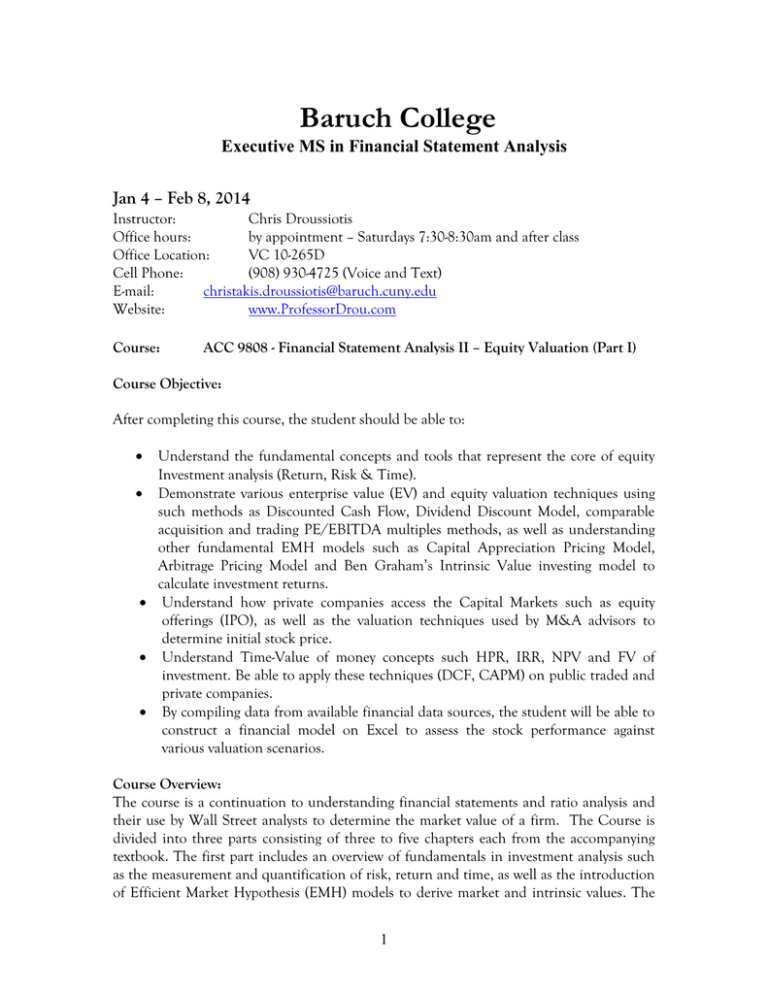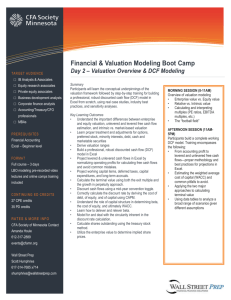Baruch College Executive MS in Financial Statement Analysis
advertisement

Baruch College Executive MS in Financial Statement Analysis Jan 4 – Feb 8, 2014 Instructor: Chris Droussiotis Office hours: by appointment – Saturdays 7:30-8:30am and after class Office Location: VC 10-265D Cell Phone: (908) 930-4725 (Voice and Text) E-mail: christakis.droussiotis@baruch.cuny.edu Website: www.ProfessorDrou.com Course: ACC 9808 - Financial Statement Analysis II – Equity Valuation (Part I) Course Objective: After completing this course, the student should be able to: Understand the fundamental concepts and tools that represent the core of equity Investment analysis (Return, Risk & Time). Demonstrate various enterprise value (EV) and equity valuation techniques using such methods as Discounted Cash Flow, Dividend Discount Model, comparable acquisition and trading PE/EBITDA multiples methods, as well as understanding other fundamental EMH models such as Capital Appreciation Pricing Model, Arbitrage Pricing Model and Ben Graham’s Intrinsic Value investing model to calculate investment returns. Understand how private companies access the Capital Markets such as equity offerings (IPO), as well as the valuation techniques used by M&A advisors to determine initial stock price. Understand Time-Value of money concepts such HPR, IRR, NPV and FV of investment. Be able to apply these techniques (DCF, CAPM) on public traded and private companies. By compiling data from available financial data sources, the student will be able to construct a financial model on Excel to assess the stock performance against various valuation scenarios. Course Overview: The course is a continuation to understanding financial statements and ratio analysis and their use by Wall Street analysts to determine the market value of a firm. The Course is divided into three parts consisting of three to five chapters each from the accompanying textbook. The first part includes an overview of fundamentals in investment analysis such as the measurement and quantification of risk, return and time, as well as the introduction of Efficient Market Hypothesis (EMH) models to derive market and intrinsic values. The 1 second part includes an overview of equity valuation analysis of publicly traded and private companies accessing the Capital Markets. This part will include case studies of Leverage Buyouts (LBO), M&A transactions and general capital investments. The third part will prepare the student to build an excel model to value publicly traded companies with the ultimate goal of assessing the company’s current stock price. Required Text: Investment Valuation - 3rd edition by Aswath Damodaran ISBN13: 978-1118130735 ISBN10: 1118130731 www.amazon.com Materials to be provided by the Instructor: IPO offering prospectus on a live deal Excel spreadsheets of various portfolio management analyses Equity and DCF / CAPM models Course Requirements: Attendance: Students are expected to attend and to participate in classroom discussions. It is important to attend every class because the Exams are based on the instructor’s lectures and classroom notes. Class participation will count as part of the course grade. Attendance accounts for 10% of your grade. Homework: Reading assignments and application projects will be assigned. Check Homework assignments and datelines on the professor’s website at www.ProfessorDrou.com under ACC9808 . Homework accounts for 15% of your grade. Also check datelines on the syllabus schedule below. Handouts The instructor will provide handouts before the class. All Handouts and lecture notes are posted on the website: www.ProfessorDrou.com under ACC9808. 2 Project: On the first class each student will be assigned a publicly traded company. The Project will consist of spreading the projections by using financial statements, valuing the company using the 4 methods of valuations taught during class. Exams: There will be a midterm (1.5 hours) and a final exam (3 hours). Midterm Studies: Text Book Chapters 1-9. Final Exam Studies: Text Book Chapters 10-17 (except 12). Grading: Mid Term Exam * Final Exam* Homework Attendance Project Total 20% 35% 15% 10% 20% 100% Academic Integrity Cheating and plagiarism are serious offenses. The following definitions are based on the College's Academic Honesty website: Cheating is the attempted or unauthorized use of materials, information, notes, study aids, devices or communication during an academic exercise. Examples include but are not limited to: Copying from another student during an examination or allowing another to copy your work Unauthorized collaborating on a take home assignment or examination Using unauthorized notes during a closed book examination Using unauthorized electronic devices during an examination Taking an examination for another student Asking or allowing another student to take an examination for you Changing a corrected exam and returning it for more credit Submitting substantial portions of the same paper to two classes without consulting the second instructor Preparing answers or writing notes in a blue book (exam booklet) before an examination Allowing others to research and write assigned papers including the use of commercial term paper services 3 Plagiarism is the act of presenting another person's ideas, research or writing as your own, such as: Copying another person's actual words without the use of quotation marks and footnotes (a functional limit is four or more words taken from the work of another) Presenting another person's ideas or theories in your own words without acknowledging them Using information that is not considered common knowledge without acknowledging the source Failure to acknowledge collaborators on homework and laboratory assignment My policy is to give a 0 grade to any assignment that has been plagiarized or an exam in which you have cheated. In addition, I am required by College policy to submit a report of suspected academic dishonesty to the Office of the Dean of Students. This report becomes part of your permanent file. Other Information Cell phones must be turn off during class 4 ACC9808 Equity Valuation Course Outline Instructor: Chris Droussiotis (908) 930-4725 christakis.droussiotis@baruch.cuny.edu Lecture * Date Chapter * 1 Jan 4 1,2 2 Jan 7 Partial 3,4 and prof’s notes 3 Jan 11 6,7, 8 4 Jan 14 11,12,13 and handout 5 Jan 18 14,15,16, 6 Jan 21 17,18,19 Handout & Powerpoint 7 Jan 25 30 & Handout Jan 28 Handout 8 Subject Handout / Spreadsheet Homework/Assignments / Exams Course Overview Introduction to Valuation Approaches to Valuation Introduction to valuation methodologies DCF, Comparable and other Understanding Financial Statements to value Equity Fundamental Analysis BV Vs MV Sharpe’s CAPM, Ross;s APM) Beta Coefficient Technical Analysis & Behavioral Analysis (EMH) HOMEWORK #1 DUE Question 3a and 3b from Text Book Riskless Rates & Risk Premiums General Models for Risk/Return Cost of Equity/WACC as Discount Rate Equity Valuation Models Building Projections Estimating Terminal Values Dividend Discount Model FCF to Equity Discount Model Trading and Acquisition Multiples Valuing a Firm /EV DCF for PublicTraded Companies P/E and EBITDA Multiples Price/Book Multiples HOMEWORK #2 DUE Handout spreadsheet Celerity Technology MIDTERM EXAM (1.5 Hours) Starwood (“HOT”) HOMEWORK #3 DUE Valuation Models DCF for Private Companies LBO and M&A Alexandria Hotel HOMEWORK #4 DUE Valuing a Company as an Option (using Black Sholes, Standard Deviation , Covariance and Variance concepts) Wang & Airline Co. Workshop: Building Equity Models on Excel using the 4 basic methods of valuation. Final Exam Preview Feb 8 FINAL EXAM All lecture notes could be obtain by going to Professor Droussiotis’s Website at www.ProfessorDrou.com under ACC9808 5 PROJECT DUE




